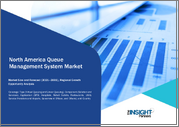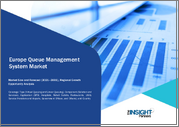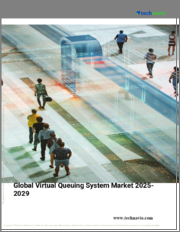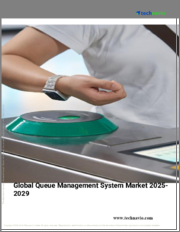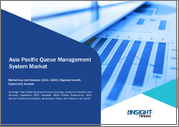
|
시장보고서
상품코드
1819716
아시아태평양의 대기열 관리 시스템 시장 보고서(2021-2031년) : 범위, 세분화, 동향, 경쟁 분석Asia Pacific Queue Management System Market Report 2021-2031 by Scope, Segmentation, Dynamics, and Competitive Analysis |
||||||
아시아태평양의 대기열 관리 시스템(QMS) 시장은 2023년에 약 1억 7,089만 달러로 평가되었으며, 예측 기간 동안 CAGR 9.0%를 반영하여 2031년까지 약 3억 3,935만 달러로 성장할 것으로 예상됩니다. 이러한 성장은 이 지역의 중소기업(SME)의 확대가 큰 영향을 미치고 있습니다.
중소기업의 부상은 대기열 관리 시스템 시장에 큰 비즈니스 기회를 가져다 줄 것으로 예상됩니다. 중소기업은 유연성과 빠른 적응력으로 유명하며, 대기업보다 더 효율적으로 고객의 특정 요구에 맞는 맞춤형 솔루션을 만들 수 있습니다. 경제협력개발기구(OECD)에 따르면, 중소기업은 많은 국가의 경제에 필수적인 존재이며, 2021년 기준 총 고용의 약 50%, 국내총생산(GDP)의 약 40%를 차지할 것으로 예상하고 있습니다. 이들 기업이 성장함에 따라 업무 효율성과 고객 경험의 중요성을 인식하게 되면서 대기열 관리 시스템 도입률이 높아지고 있습니다.
중소기업이 성장함에 따라 신속하고 효율적인 서비스에 대한 고객의 기대가 높아짐에 따라 효과적인 고객 흐름 관리가 필수적으로 요구되고 있습니다. 대기열 관리 시스템은 업무 간소화, 대기 시간 최소화, 서비스 제공 강화에 필요한 도구를 갖추고 있어 경쟁 상황에서 고객 유지에 필수적입니다. 또한, 중소기업에서는 디지털 솔루션의 통합이 진행됨에 따라 실시간 데이터 분석을 활용하여 서비스 프로세스를 최적화하는 고도화된 QMS의 도입이 용이해지고 있습니다. 이러한 추세는 고객 만족도를 높일 뿐만 아니라 중소기업이 더 높은 생산성과 업무 효율성을 달성하는 데 도움이 되며, 시장에서의 지속가능성을 높일 수 있습니다.
아시아태평양의 대기열 관리 시스템 시장에는 호주, 중국, 한국, 인도, 일본, 기타 아시아태평양 등의 주요 지역이 포함됩니다. 이 시장은 특히 중국, 인도와 같이 시장 개척이 빠르게 진행되고 있는 국가와 일본과 같은 신흥 경제국에서 큰 성장 가능성을 보여주고 있습니다. 아시아태평양의 서비스 부문은 자동화, 인공지능(AI), 클라우드 기반 솔루션, 기타 혁신 기술을 빠르게 도입하고 있습니다. 경쟁력을 유지하기 위해 아시아태평양 전체에서 디지털 기능을 지속적으로 추진하고 있습니다. 예를 들어, 중국 정부는 2023년 2월 경제, 정치, 문화, 사회, 환경 등 다양한 분야에서 디지털 기술 활용을 촉진하기 위한 '디지털 중국 발전 종합 배치 계획'을 발표했습니다. 중국은 2025년까지 종합적인 디지털 시스템을 구축할 계획이며, 2035년까지 세계 최고 수준의 디지털화 국가로 도약하는 것을 목표로 하고 있습니다. 이러한 지속적인 디지털 혁신은 대기열 관리 시스템에 대한 수요를 촉진하고 예측 기간 동안 시장 성장을 더욱 촉진할 것으로 예상됩니다.
Seehash Software Pvt.Ltd, XIPHIAS Software Technologies Pvt.Ltd, Aurionpro Solutions Limited와 같은 주요 기업들이 아시아태평양의 대기열 관리 시스템 시장을 주도하고 있습니다. 이들 기업은 혁신적인 대기열 관리 솔루션 개발에 전념하고 있습니다. 예를 들어, Aurionpro Solutions Limited의 OptiQ 시스템은 은행, 헬스케어, 항공 등 다양한 분야에서 널리 사용되고 있습니다. OptiQ는 실시간 지점 분석과 동적 고객 인텔리전스를 통합하여 고객 흐름을 강화하고 전체 고객 여정을 개선합니다. 특히 은행, 금융 서비스 및 보험(BFSI) 부문은 기술 발전이 빠르게 진행되고 있으며, IDC Financial Insights 보고서에 따르면 2022년 6월 기준 아시아 은행의 92%가 클라우드에 대한 지출을 늘릴 계획이라고 합니다. 은행의 대기열 관리 시스템에는 종종 셀프서비스 키오스크가 포함되어 정형화된 거래를 용이하게 하여 대기 시간을 크게 단축하고 인적 오류를 최소화할 수 있습니다.
아시아태평양의 대기열 관리 시스템 시장은 유형, 구성요소, 용도, 국가별로 분류됩니다. 유형별로 시장은 가상 큐잉과 선형 큐잉으로 나뉘며, 2023년에는 가상 큐잉 부문이 더 큰 시장 점유율을 차지했습니다. 구성요소의 경우, 시장은 솔루션과 서비스로 분류되며, 솔루션 부문이 시장 점유율을 주도하고 있습니다. 용도별로는 BFSI, 병원, 소매점, 레스토랑, 공공 서비스 제공업체, 공항, 관공서, 기타가 포함되며, 2023년에는 소매점이 가장 큰 부문이 되었습니다.
지역별로는 호주, 중국, 일본, 인도, 한국, 기타 아시아태평양으로 구분되며, 2023년에는 중국이 시장 점유율을 독식했습니다.
아시아태평양의 대기열 관리 시스템 시장의 주요 기업으로는 Q-MATIC Group AB, Qminder Ltd, Q-nomy Inc, Skiplino, Wavetec, Aurionpro Solutions Ltd, Advantech Co Ltd, SEDCO Co Ltd, Lavi Industries, AKIS Technologies UAB, WaitWell, Verint Systems Inc, QLESS, OFFTEC Holding Group, Waitwhile Inc 등이 있습니다. 이들 기업은 아시아태평양의 다양한 산업의 다양한 요구에 대응하는 대기열 관리 시스템 개발 및 도입의 최전선에 서 있습니다.
목차
제1장 소개
제2장 주요 요약
- 주요 인사이트
- 시장 매력
제3장 조사 방법
- 2차 조사
- 1차 조사
- 가설 책정
- 거시경제 요인 분석
- 기초 수치 개발
- 데이터 삼각측량
- 국가 레벨 데이터
- 가정과 제한
제4장 아시아태평양의 대기열 관리 시스템 시장 상황
- PEST 분석
- 생태계 분석
- 밸류체인 벤더 리스트
제5장 아시아태평양의 대기열 관리 시스템 시장 : 주요 시장 역학
- 시장 성장 촉진요인
- 고객 경험 향상 요구 상승
- 다양한 업계의 QMS 적용 확대와 트래픽 증가
- 시장 성장 억제요인
- QMS 도입에 따른 복잡성
- 세계의 비즈니스 특화형 온라인 플랫폼의 현저한 성장
- 시장 기회
- 중소기업 성장
- 기타 업무 시스템과의 통합
- 향후 동향
- AI를 활용한 대기열 관리 시스템
- 성장 촉진요인과 억제요인의 영향
제6장 대기열 관리 시스템 시장 : 아시아태평양의 분석
- 아시아태평양의 대기열 관리 시스템 시장 매출, 2021-2031년
- 아시아태평양의 대기열 관리 시스템 시장 예측 분석
제7장 아시아태평양의 대기열 관리 시스템 시장 분석 - 유형별
- 가상 대기열
- 선형 대기열
제8장 아시아태평양의 대기열 관리 시스템 시장 분석 - 구성요소별
- 솔루션
- 서비스
제9장 아시아태평양의 대기열 관리 시스템 시장 분석 - 용도별
- BFSI
- 병원
- 소매점포
- 레스토랑
- 공공 서비스 프로바이더와 공항
- 관공청
- 기타
제10장 아시아태평양의 대기열 관리 시스템 시장 : 국가별 분석
- 아시아태평양
- 호주
- 중국
- 인도
- 일본
- 한국
- 아시아태평양의 기타 국가
제11장 경쟁 구도
- 히트맵 분석 : 주요 기업별
- 기업 포지셔닝과 집중도
제12장 업계 상황
- 시장 이니셔티브
- 파트너십과 제휴
- 기타 개발
제13장 기업 개요
- Q-MATIC Group AB
- Qminder Ltd
- Q-nomy Inc
- Skiplino
- Wavetec
- Aurionpro Solutions Ltd
- Advantech Co Ltd
- SEDCO Co Ltd
- Lavi Industries
- AKIS Technologies UAB
- WaitWell
- Verint Systems Inc
- QLESS
- OFFTEC Holding Group
- Waitwhile, Inc
제14장 부록
KSM 25.10.02The Asia Pacific queue management system (QMS) market was valued at approximately US$ 170.89 million in 2023 and is projected to grow to around US$ 339.35 million by 2031, reflecting a compound annual growth rate (CAGR) of 9.0% during the forecast period. This growth is significantly influenced by the expansion of small and medium enterprises (SMEs) in the region.
The rise of SMEs is expected to create considerable opportunities for the queue management system market. SMEs are known for their flexibility and ability to adapt quickly, allowing them to create customized solutions that cater to specific customer needs more effectively than larger corporations. According to the Organisation for Economic Co-operation and Development (OECD), SMEs are vital to the economies of many countries, accounting for about 50% of total employment and 40% of gross domestic product (GDP) as of 2021. As these enterprises continue to grow, they increasingly recognize the importance of operational efficiency and customer experience, leading to a higher adoption rate of queue management systems.
As SMEs expand, they encounter rising customer expectations for prompt and efficient service, making effective customer flow management essential. Queue management systems equip these businesses with the necessary tools to streamline operations, minimize wait times, and enhance service delivery, which is crucial for customer retention in a competitive landscape. Additionally, the growing integration of digital solutions within SMEs facilitates the implementation of advanced QMS that leverage real-time data analytics to optimize service processes. This trend not only boosts customer satisfaction but also helps SMEs achieve greater productivity and operational efficiency, thereby enhancing their sustainability in the market.
The Asia Pacific queue management system market encompasses several key regions, including Australia, China, South Korea, India, Japan, and the Rest of Asia Pacific. The market exhibits significant growth potential, particularly in rapidly developing countries like China and India, as well as in more established economies such as Japan. The service sector in the Asia Pacific region is rapidly embracing automation, artificial intelligence (AI), cloud-based solutions, and other innovative technologies. To maintain competitiveness, there is a continuous push for digital capabilities across the region. For example, in February 2023, the Chinese government released the Overall Layout Plan for the development of a Digital China, aiming to promote the use of digital technology across various sectors, including economic, political, cultural, social, and environmental domains. By 2025, China plans to establish a comprehensive digital system, with aspirations to rank among the top countries globally in terms of digitalization by 2035. This ongoing digital transformation is expected to drive demand for queue management systems, further propelling market growth during the forecast period.
The Asia Pacific queue management system market is also supported by a strong presence of key players such as Seehash Softwares Pvt. Ltd., XIPHIAS Software Technologies Pvt. Ltd., and Aurionpro Solutions Limited. These companies are dedicated to developing innovative queue management solutions. For instance, Aurionpro Solutions Limited's OptiQ system is widely adopted across various sectors, including banking, healthcare, and aviation. OptiQ integrates real-time branch analytics and dynamic customer intelligence to enhance customer flow and improve the overall customer journey. The banking, financial services, and insurance (BFSI) sector, in particular, is experiencing technological advancements, with a report from IDC Financial Insights indicating that 92% of banks in Asia planned to increase their cloud spending as of June 2022. Queue management systems in banks often include self-service kiosks that facilitate routine transactions, significantly reducing wait times and minimizing human error.
The Asia Pacific queue management system market is segmented by type, component, application, and country. In terms of type, the market is divided into virtual queuing and linear queuing, with the virtual queuing segment holding a larger market share in 2023. Regarding components, the market is categorized into solutions and services, with the solutions segment also leading in market share. By application, the market includes sectors such as BFSI, hospitals, retail outlets, restaurants, utility service providers, airports, government offices, and others, with retail outlets representing the largest segment in 2023.
Geographically, the market is segmented into Australia, China, Japan, India, South Korea, and the Rest of Asia Pacific, with China dominating the market share in 2023.
Prominent companies in the Asia Pacific queue management system market include Q-MATIC Group AB, Qminder Ltd, Q-nomy Inc, Skiplino, Wavetec, Aurionpro Solutions Ltd, Advantech Co Ltd, SEDCO Co Ltd, Lavi Industries, AKIS Technologies UAB, WaitWell, Verint Systems Inc, QLESS, OFFTEC Holding Group, and Waitwhile Inc. These companies are at the forefront of developing and implementing queue management systems that cater to the diverse needs of various industries across the Asia Pacific region.
Table Of Contents
1. Introduction
- 1.1 Report Guidance
- 1.2 Market Segmentation
2. Executive Summary
- 2.1 Key Insights
- 2.2 Market Attractiveness
3. Research Methodology
- 3.1 Secondary Research
- 3.2 Primary Research
- 3.2.1 Hypothesis formulation:
- 3.2.2 Macroeconomic factor analysis:
- 3.2.3 Developing base number:
- 3.2.4 Data Triangulation:
- 3.2.5 Country-level data:
- 3.3 Assumptions and Limitations
4. Asia Pacific Queue Management System Market Landscape
- 4.1 Overview
- 4.2 PEST Analysis
- 4.3 Ecosystem Analysis
- 4.4 List of Vendors in the Value Chain
5. Asia Pacific Queue Management System Market - Key Market Dynamics
- 5.1 Market Drivers
- 5.1.1 Growing Need for Enhanced Customer Experience
- 5.1.2 Rising Application of QMS and Increasing Foot Traffic in Various Industries
- 5.2 Market Restraints
- 5.2.1 Complexities Associated with QMS Implementation
- 5.2.2 Tremendous Growth in Business-Specific Online Platforms Worldwide
- 5.3 Market Opportunities
- 5.3.1 Growth of Small and Medium Enterprises
- 5.3.2 Integration with Other Business Systems
- 5.4 Future Trends
- 5.4.1 AI-Powered Queue Management System
- 5.5 Impact of Drivers and Restraints:
6. Queue Management System Market - Asia Pacific Analysis
- 6.1 Asia Pacific Queue Management System Market Revenue (US$ Million), 2021-2031
- 6.2 Asia Pacific Queue Management System Market Forecast Analysis
7. Asia Pacific Queue Management System Market Analysis - by Type
- 7.1 Virtual Queuing
- 7.1.1 Overview
- 7.1.2 Virtual Queuing: Asia Pacific Queue Management System Market - Revenue and Forecast, 2021-2031 (US$ Million)
- 7.2 Linear Queuing
- 7.2.1 Overview
- 7.2.2 Linear Queuing: Asia Pacific Queue Management System Market - Revenue and Forecast, 2021-2031 (US$ Million)
8. Asia Pacific Queue Management System Market Analysis - by Component
- 8.1 Solution
- 8.1.1 Overview
- 8.1.2 Solution: Asia Pacific Queue Management System Market - Revenue and Forecast, 2021-2031 (US$ Million)
- 8.2 Services
- 8.2.1 Overview
- 8.2.2 Services: Asia Pacific Queue Management System Market - Revenue and Forecast, 2021-2031 (US$ Million)
9. Asia Pacific Queue Management System Market Analysis - by Application
- 9.1 BFSI
- 9.1.1 Overview
- 9.1.2 BFSI: Asia Pacific Queue Management System Market - Revenue and Forecast, 2021-2031 (US$ Million)
- 9.2 Hospitals
- 9.2.1 Overview
- 9.2.2 Hospitals: Asia Pacific Queue Management System Market - Revenue and Forecast, 2021-2031 (US$ Million)
- 9.3 Retail Outlets
- 9.3.1 Overview
- 9.3.2 Retail Outlets: Asia Pacific Queue Management System Market - Revenue and Forecast, 2021-2031 (US$ Million)
- 9.4 Restaurants
- 9.4.1 Overview
- 9.4.2 Restaurants: Asia Pacific Queue Management System Market - Revenue and Forecast, 2021-2031 (US$ Million)
- 9.5 Utility Service Providers and Airports
- 9.5.1 Overview
- 9.5.2 Utility Service Providers and Airports: Asia Pacific Queue Management System Market - Revenue and Forecast, 2021-2031 (US$ Million)
- 9.6 Government Offices
- 9.6.1 Overview
- 9.6.2 Government Offices: Asia Pacific Queue Management System Market - Revenue and Forecast, 2021-2031 (US$ Million)
- 9.7 Others
- 9.7.1 Overview
- 9.7.2 Others: Asia Pacific Queue Management System Market - Revenue and Forecast, 2021-2031 (US$ Million)
10. Asia Pacific Queue Management System Market - Country Analysis
- 10.1 Asia Pacific
- 10.1.1 Asia Pacific Queue Management System Market - Revenue and Forecast Analysis - by Country
- 10.1.1.1 Asia Pacific Queue Management System Market - Revenue and Forecast Analysis - by Country
- 10.1.1.2 Australia: Asia Pacific Queue Management System Market - Revenue and Forecast, 2021-2031 (US$ Million)
- 10.1.1.2.1 Australia: Asia Pacific Queue Management System Market Share - by Type
- 10.1.1.2.2 Australia: Asia Pacific Queue Management System Market Share - by Component
- 10.1.1.2.3 Australia: Asia Pacific Queue Management System Market Share - by Application
- 10.1.1.3 China: Asia Pacific Queue Management System Market - Revenue and Forecast, 2021-2031 (US$ Million)
- 10.1.1.3.1 China: Asia Pacific Queue Management System Market Share - by Type
- 10.1.1.3.2 China: Asia Pacific Queue Management System Market Share - by Component
- 10.1.1.3.3 China: Asia Pacific Queue Management System Market Share - by Application
- 10.1.1.4 India: Asia Pacific Queue Management System Market - Revenue and Forecast, 2021-2031 (US$ Million)
- 10.1.1.4.1 India: Asia Pacific Queue Management System Market Share - by Type
- 10.1.1.4.2 India: Asia Pacific Queue Management System Market Share - by Component
- 10.1.1.4.3 India: Asia Pacific Queue Management System Market Share - by Application
- 10.1.1.5 Japan: Asia Pacific Queue Management System Market - Revenue and Forecast, 2021-2031 (US$ Million)
- 10.1.1.5.1 Japan: Asia Pacific Queue Management System Market Share - by Type
- 10.1.1.5.2 Japan: Asia Pacific Queue Management System Market Share - by Component
- 10.1.1.5.3 Japan: Asia Pacific Queue Management System Market Share - by Application
- 10.1.1.6 South Korea: Asia Pacific Queue Management System Market - Revenue and Forecast, 2021-2031 (US$ Million)
- 10.1.1.6.1 South Korea: Asia Pacific Queue Management System Market Share - by Type
- 10.1.1.6.2 South Korea: Asia Pacific Queue Management System Market Share - by Component
- 10.1.1.6.3 South Korea: Asia Pacific Queue Management System Market Share - by Application
- 10.1.1.7 Rest of APAC: Asia Pacific Queue Management System Market - Revenue and Forecast, 2021-2031 (US$ Million)
- 10.1.1.7.1 Rest of APAC: Asia Pacific Queue Management System Market Share - by Type
- 10.1.1.7.2 Rest of APAC: Asia Pacific Queue Management System Market Share - by Component
- 10.1.1.7.3 Rest of APAC: Asia Pacific Queue Management System Market Share - by Application
- 10.1.1 Asia Pacific Queue Management System Market - Revenue and Forecast Analysis - by Country
11. Competitive Landscape
- 11.1 Heat Map Analysis by Key Players
- 11.2 Company Positioning and Concentration
12. Industry Landscape
- 12.1 Overview
- 12.2 Market Initiative
- 12.3 Partnerships and Collaborations
- 12.4 Other Developments
13. Company Profiles
- 13.1 Q-MATIC Group AB
- 13.1.1 Key Facts
- 13.1.2 Business Description
- 13.1.3 Products and Services
- 13.1.4 Financial Overview
- 13.1.5 SWOT Analysis
- 13.1.6 Key Developments
- 13.2 Qminder Ltd
- 13.2.1 Key Facts
- 13.2.2 Business Description
- 13.2.3 Products and Services
- 13.2.4 Financial Overview
- 13.2.5 SWOT Analysis
- 13.2.6 Key Developments
- 13.3 Q-nomy Inc
- 13.3.1 Key Facts
- 13.3.2 Business Description
- 13.3.3 Products and Services
- 13.3.4 Financial Overview
- 13.3.5 SWOT Analysis
- 13.3.6 Key Developments
- 13.4 Skiplino
- 13.4.1 Key Facts
- 13.4.2 Business Description
- 13.4.3 Products and Services
- 13.4.4 Financial Overview
- 13.4.5 SWOT Analysis
- 13.4.6 Key Developments
- 13.5 Wavetec
- 13.5.1 Key Facts
- 13.5.2 Business Description
- 13.5.3 Products and Services
- 13.5.4 Financial Overview
- 13.5.5 SWOT Analysis
- 13.5.6 Key Developments
- 13.6 Aurionpro Solutions Ltd
- 13.6.1 Key Facts
- 13.6.2 Business Description
- 13.6.3 Products and Services
- 13.6.4 Financial Overview
- 13.6.5 SWOT Analysis
- 13.6.6 Key Developments
- 13.7 Advantech Co Ltd
- 13.7.1 Key Facts
- 13.7.2 Business Description
- 13.7.3 Products and Services
- 13.7.4 Financial Overview
- 13.7.5 SWOT Analysis
- 13.7.6 Key Developments
- 13.8 SEDCO Co Ltd
- 13.8.1 Key Facts
- 13.8.2 Business Description
- 13.8.3 Products and Services
- 13.8.4 Financial Overview
- 13.8.5 SWOT Analysis
- 13.8.6 Key Developments
- 13.9 Lavi Industries
- 13.9.1 Key Facts
- 13.9.2 Business Description
- 13.9.3 Products and Services
- 13.9.4 Financial Overview
- 13.9.5 SWOT Analysis
- 13.9.6 Key Developments
- 13.10 AKIS Technologies UAB
- 13.10.1 Key Facts
- 13.10.2 Business Description
- 13.10.3 Products and Services
- 13.10.4 Financial Overview
- 13.10.5 SWOT Analysis
- 13.10.6 Key Developments
- 13.11 WaitWell
- 13.11.1 Key Facts
- 13.11.2 Business Description
- 13.11.3 Products and Services
- 13.11.4 Financial Overview
- 13.11.5 SWOT Analysis
- 13.11.6 Key Developments
- 13.12 Verint Systems Inc
- 13.12.1 Key Facts
- 13.12.2 Business Description
- 13.12.3 Products and Services
- 13.12.4 Financial Overview
- 13.12.5 SWOT Analysis
- 13.12.6 Key Developments
- 13.13 QLESS
- 13.13.1 Key Facts
- 13.13.2 Business Description
- 13.13.3 Products and Services
- 13.13.4 Financial Overview
- 13.13.5 SWOT Analysis
- 13.13.6 Key Developments
- 13.14 OFFTEC Holding Group
- 13.14.1 Key Facts
- 13.14.2 Business Description
- 13.14.3 Products and Services
- 13.14.4 Financial Overview
- 13.14.5 SWOT Analysis
- 13.14.6 Key Developments
- 13.14.7 Key Developments by OFFTEC Group in the Queue Management System Market
- 13.15 Waitwhile, Inc
- 13.15.1 Key Facts
- 13.15.2 Business Description
- 13.15.3 Products and Services
- 13.15.4 Financial Overview
- 13.15.5 SWOT Analysis
- 13.15.6 Key Developments
14. Appendix
- 14.1 About The Insight Partners
- 14.2 Word Index








